
Last year there was a spate of books specifically about bird “behavior” – though one might well say that every book about birds, from field guides on up, is about behavior in some way or another. It’s the behavior that makes them fascinating to us. (Well, purely physical attributes play a part, too: they’re pretty good looking.)
You can’t say the same about migration: you can’t say that every book about birds is necessarily about migration, for the simple reason that only about 4,000 bird species migrate (with some 1,800 of those traveling long distances). Nevertheless migration is, one could safely assume, a subject of great fascination to all birders, and it is the subject, also, of some good books in recent years: Scott Weidensaul’s A World on the Wing and Kenn Kaufman’s A Season on the Wind, among others.
Very much deserving of notice, as well, is the handsome and substantial Flights of Passage: An illustrated natural history of bird migration, by Mike Unwin and David Tipling. It takes a different approach from the Weidensaul and Kaufman books, but it is excellent and impressive in every way, and about as stunning a production as some of the migrations it describes.
Flights of Passage describes the seasonal travels of 67 species from different parts of the globe, “chosen to showcase migratory behavior,” the authors say, “across a broad spectrum.” Thus, the book includes a number of migratory champions well-known to many birders: the Bar-Tailed Godwit (Alaska to New Zealand, non-stop, in nine days) and the Blackpoll Warbler (from Alaska eastwards across the entire continent before turning south to cross the Atlantic) — but also the Emperor Penguin, one of the few birds to migrate on foot (from the ocean to their breeding colonies, 30 -75 miles away across the pack ice).
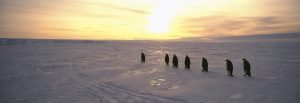
A “broad spectrum,” indeed.
After a good introduction called “The Miracle of Migration,” the substance of the book is organized not by strict taxonomy, but by “loose association” into six sections: Wildfowl and Diving Birds, Seabirds, Shorebirds and Waders, Songbirds, Raptors and Owls, and “Other Bird Migrations.”
In the latter category are included the Common Cuckoo, the European one, the one celebrated by Shakespeare, Beethoven, and Wordsworth, which, as they surely did not know, winters in Africa; the Southern Carmine Bee-Eater, an intra-Africa migrant; and the gorgeous (see photo below) Pin-tailed Sandgrouse, an irregular migrant of two subspecies, often irruptive:
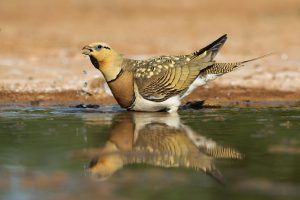
Each of the 67 species noted in the book gets two or three or four pages, starting with brief stats — size, appearance, lifestyle, range and migration, and status (thriving, endangered, or somewhere in-between) of the species. A simple, useful world map in outline shows approximate breeding ranges in yellow and wintering ranges in blue, and for some birds, permanent resident ranges in green.
The page or two of text for each bird has some good stuff, not all pertaining to migration. Some birds with populations on different breeding grounds move not to the same winter quarter but to far-distant ones – such as the Red-necked Phalarope. Once it was thought that all Red-necked Phalaropes migrated overland to the Arabian Sea and Indian Ocean. Only recently was it discovered that one group, which breeds on the Shetland Islands, flies across the Atlantic to winter off the coast of Ecuador – ten thousand miles away from its cousins who breed in Scandanavia and western Russia.
And, “as if to prove it does everything differently,” the authors say, these phalaropes are polyandrous, with the females laying multiple clutches and leaving the various fathers to incubate and rear the broods.
The subtitle puts the word “illustrated” in italics — that must mean something. If it means that the authors think that this – the many fine photographs, by David Tipling — is distinctive in books about migration, and that it’s something of which he, and they, are, and should be, proud, they’re right on both counts, as the examples below (clockwise from upper left: Lesser Flamingos in Kenya, Turtle Doves in Norfolk, Osprey in the Scottish Highlands, Wandering Albatrosses on South Georgia Island) show:
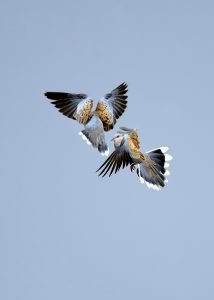
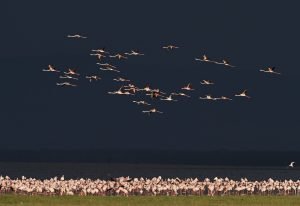
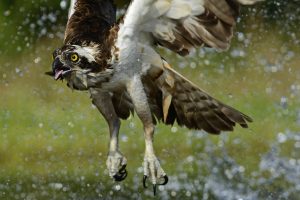
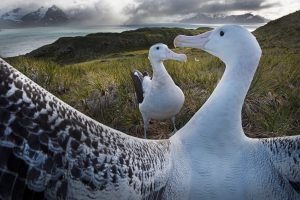
There are two things that Flights of Passage and other recent works show above all.
First is the dramatic effect very recent technologies have on our knowledge of migration, our ability to solve longstanding mysteries. Only in the last 200 years, after all, has bird migration been accepted as a fact; but in the last few years alone, the increase in knowledge has been, seemingly, exponential. The use of satellite tracking and miniaturization (including geolocators that can be attached to fledglings) and other wonders has made migration seem even more marvelous than had been known already.
Second (as if the reader needed reminding) is the peril birds are in generally. There are 59 million mature Blackpolls, which sounds good until the authors note that their population declined by 92 percent between 1970 and 2014: the math alone seems unbelievable.
And, in a nice irony, an example par excellence of the law of unintended consequences: the Redhead, a diving duck, has an aversion to wind turbines, and will change its feeding areas to avoid them. “Scientists fear that this may cause them to lose condition over winter and thus damage their breeding prospects.”
In other words, wind turbines don’t harm birds just by smashing them to smithereens — they harm birds by merely existing.
Migration is hard enough without anthropogenic threats. So why do it at all? Simple, the authors say: “the risks of staying behind outweigh those of moving on.”

____________________________________________________________________________________________
[Photos in the body of the review, above, by David Tipling.]
Flights of Passage: An illustrated natural history of bird migration. By Mike Unwin and David Tipling. Yale University Press, New Haven and London, May 19, 2020. 288 pp., 9 ¼ x 11 3/8, $40. ISBN 9780300247442.













Leave a Comment